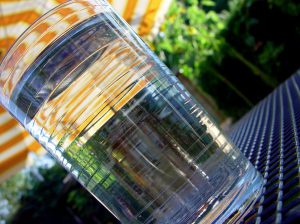 The short answer is yes. But, to elaborate on this point it’s a good idea to understand what chlorine is, why it’s in your water, and why you may want to consider removing it. In this article, we will explore this topic in more depth to help you make an informed decision for your family.
The short answer is yes. But, to elaborate on this point it’s a good idea to understand what chlorine is, why it’s in your water, and why you may want to consider removing it. In this article, we will explore this topic in more depth to help you make an informed decision for your family.
What is Chlorine?
This element was only officially recognized in 1810 and it’s found in various forms in both seawater and throughout the Earth’s crust. The etymology of the word is interesting, it comes from the Greek word “chloros” which is a yellowish-green color. Chlorine, like many other elements, can exist in each of the three states of matter. As a solid, chlorine can be found in crystalline rock salt and other naturally occurring compounds. When chlorine is cooled, it can exist in a liquid state and when chlorine is at room temperature it becomes gaseous. Most people recognize chlorine as an effective disinfectant and cleaning agent in its solid form. It is the active ingredient in bleach and this is why chlorine treated drinking water may have a “swimming pool” or bleach-like odor.
What is Chloramine?
Chloramine is a name for a group of chemical compounds that have chlorine contained within them. Chloramine often combines ammonia and other substances with chlorine to boost its efficacy as a cleaning agent.
Why is Chlorine or Chloramine in My Drinking Water?
Chlorine has been used to treat water for many years and it can kill a wide variety of potentially harmful microorganisms. This is why you may smell chlorine when you turn on a faucet and this is especially noticeable if you live closer to the water treatment plant. Why? Well, the plant will add more chlorine or chloramine to maintain efficacy as the drinking water travels through the entire water delivery network. So, if you live closer to the water treatment plant the concentration of chlorine or chloramine will be higher. Chlorine has been used to treat water in the U.S. and Canada for over 90 years!
Why Would I Want to Remove the Chlorine?
Chlorine is effective at neutralizing potentially harmful microorganisms, including bacteria, viruses, pathogens, and more. But, this comes at a cost, the aesthetic quality of the drinking water may be degraded and if water tastes bad people are less likely to drink it. Food cooked in chlorine treated water can taste bland and look unappetizing. Another cause for concern is recent research that suggests that chlorine byproduct found in treated water may be a health risk. More research is required in this area, but it’s fair to say that removing chlorine and chloramine and their associated byproducts will improve the quality of your water.
How Can I Remove Chlorine?
The most reliable option is a water filtration system that has been certified by the WQA to the NSF /ANSI Standard 372 and Standard 42 for the reduction of chlorine tastes and odors. The most effective systems use granular activated carbon (GAC) filters and an undersink reverse osmosis (RO) filter can remove chlorine and a wider range of other contaminants too.
If you want to improve the quality of your drinking water, contact your local water treatment specialist today.
